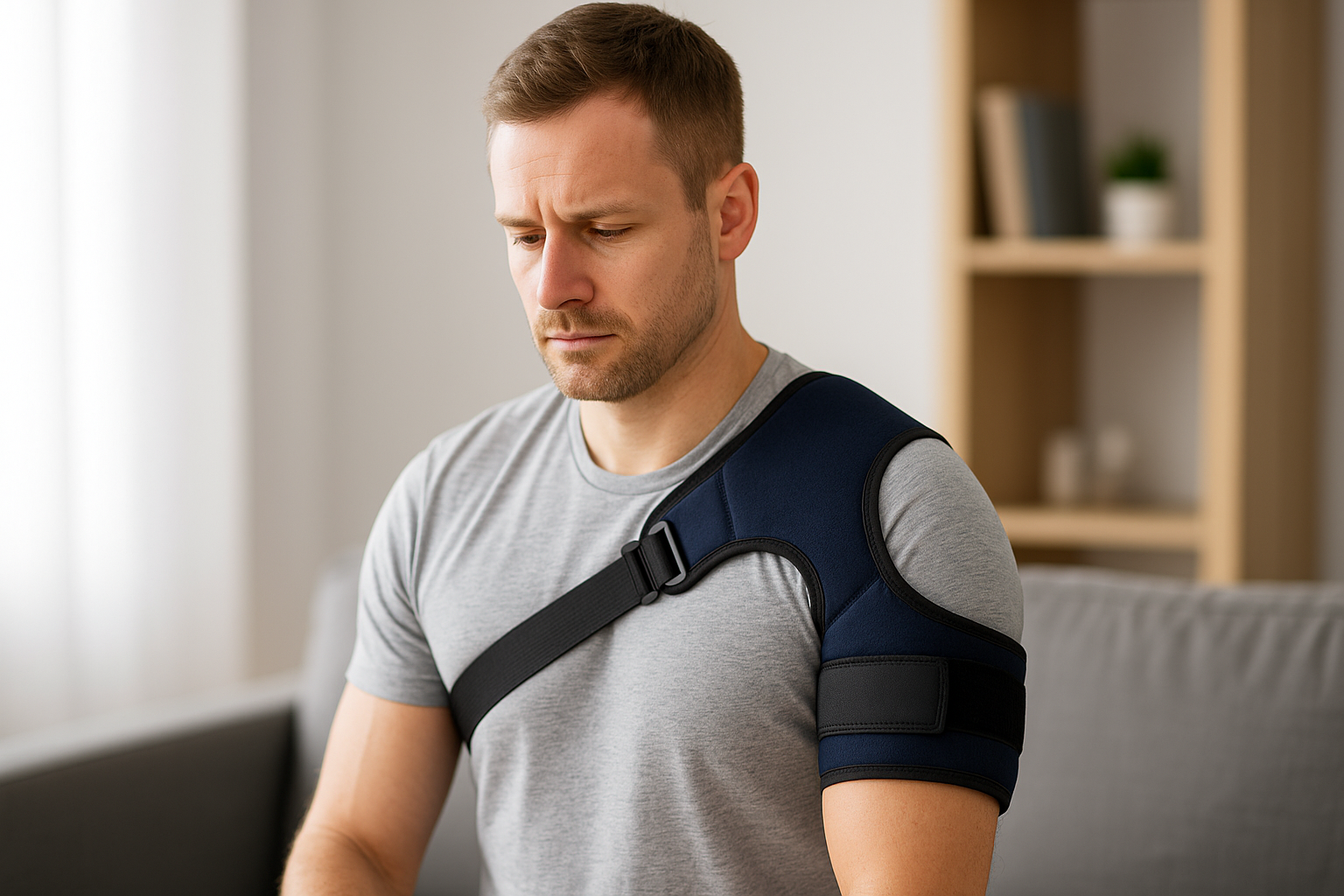Wearing a shoulder brace can be an essential part of recovering from an injury, surgery, or chronic pain. It provides the stability and support your shoulder needs to heal properly but many people wonder how long they should actually wear one.
The answer depends on your condition, the type of brace, and your stage of recovery. Wearing it for too short a time may slow healing, while overuse could weaken the muscles or limit mobility.
In this article, we’ll explain how long to wear a shoulder brace, what factors influence the duration, and how to find the right balance between support and freedom of movement for an effective recovery.
How long should you wear a shoulder brace after an injury or surgery?
Wearing a shoulder brace after an injury or surgery plays a crucial role in recovery. It stabilises the joint, limits harmful movement, and supports healing tissues but how long you should wear it depends on the type and severity of your condition, as well as your doctor’s recommendations. The duration can vary from a few days to several weeks, and finding the right balance between protection and mobility is key to a safe, effective recovery.
The general timeframe for wearing a shoulder brace
In most cases, a shoulder brace is worn for 2 to 6 weeks following an injury or surgical procedure. This period allows the soft tissues muscles, tendons, and ligaments to repair without excessive stress. During this time, immobilisation helps prevent further damage and ensures the shoulder remains properly aligned.
However, this timeframe is only a guideline. The exact duration can vary depending on your condition:
-
Minor sprains or strains:
If you’ve suffered a mild shoulder strain, the brace may be needed for 1 to 2 weeks to provide light support and reduce pain while the tissues heal. -
Dislocations or ligament injuries:
After a shoulder dislocation or ligament tear, immobilisation is typically required for 3 to 4 weeks, followed by gradual reintroduction of movement under physiotherapy supervision. -
Post-surgery recovery:
After surgical procedures such as rotator cuff repair, labrum surgery, or joint stabilisation, the brace is usually worn for 4 to 6 weeks, depending on your surgeon’s advice.
Each recovery plan is tailored to the patient. Wearing the brace longer than necessary may cause stiffness or muscle weakness, while removing it too early risks re-injury which is why following medical guidance is essential.
The purpose of wearing a brace during recovery
The main purpose of a shoulder brace after injury or surgery is to protect healing tissues. It limits excessive motion, reduces tension on the ligaments and tendons, and keeps the shoulder in the correct anatomical position.
Early in recovery, the brace ensures joint stability while inflammation subsides and scar tissue forms. As you progress, the brace gradually allows controlled mobility, helping you transition safely toward full range of motion.
A shoulder brace also plays a key role in pain management. The compression and support it provides help reduce inflammation and swelling, making it easier to perform light daily tasks without discomfort.
Transitioning out of the shoulder brace
When your doctor or physiotherapist decides it’s time to remove the brace, the process should be gradual. The muscles around the shoulder may feel weak after several weeks of limited use, so it’s important to reintroduce movement slowly.
Rehabilitation typically includes:
-
Gentle stretching to restore flexibility.
-
Strengthening exercises to rebuild muscle stability.
-
Controlled motion to regain coordination and prevent stiffness.
Most patients transition from full-time brace use to part-time support before eventually discontinuing it. Some people continue wearing a lighter brace during sports or strenuous activity to prevent future injuries.
Factors that influence how long you should wear a brace
Several factors determine how long you need to wear a shoulder brace:
-
Type of injury or surgery: Severe tears or major surgeries require longer immobilisation than mild sprains.
-
Healing progress: If recovery is slower due to age, pre-existing conditions, or poor circulation, brace use may be extended.
-
Activity level: Active individuals or athletes may wear the brace longer for added protection during physical activity.
-
Medical supervision: Always follow your healthcare provider’s recommendations they’ll adjust your plan based on progress and comfort.
Can you wear a shoulder brace too long?
Yes, you can wear a shoulder brace for too long, and doing so may actually slow your recovery instead of helping it. While a shoulder brace is essential in the early stages of healing providing support, stability, and pain relief wearing it beyond the recommended period can lead to muscle weakness, stiffness, and reduced mobility.
A shoulder brace works by immobilising the joint to allow injured tissues to heal properly. However, once recovery reaches a certain point, your muscles need to be reactivated through gentle movement and exercise. Prolonged immobilisation prevents this from happening, causing the muscles around the shoulder particularly the rotator cuff and deltoids to lose strength and flexibility. Over time, this can make the shoulder more vulnerable to re-injury.
Another issue with overuse is joint stiffness. The longer the brace keeps your shoulder still, the more difficult it becomes to regain full range of motion. When the joint isn’t used regularly, connective tissues tighten, and circulation decreases, which can slow healing rather than support it.
It’s also important to consider postural balance. Wearing a brace too long can cause overcompensation from surrounding muscles, especially in the neck and upper back. This may lead to tension, discomfort, or poor alignment over time.
The ideal duration for wearing a shoulder brace depends on your condition, but in most cases, 2 to 6 weeks is sufficient. Your doctor or physiotherapist will determine when it’s time to start weaning off the brace and introducing gentle exercises.
To avoid wearing your brace too long, always follow professional guidance. As recovery progresses, your shoulder needs controlled movement to rebuild strength, flexibility, and confidence. A shoulder brace is a temporary tool not a permanent solution and when used correctly, it supports full, lasting recovery.
What happens after you stop wearing a shoulder brace?
After you stop wearing a shoulder brace, your recovery process enters a new and crucial stage rebuilding strength, restoring flexibility, and regaining full mobility. While the brace provides vital support during the early healing phase, the next step focuses on retraining your muscles and joints to function naturally again without external assistance.
When the brace is removed, you may initially feel stiffness, weakness, or slight discomfort in your shoulder. This is completely normal. Because the joint has been immobilised for several weeks, the surrounding muscles such as the rotator cuff, deltoids, and upper back muscles may have lost some tone and flexibility. At this stage, physiotherapy and guided exercises play a key role in restoring balance, coordination, and strength.
Most recovery programmes include progressive movement exercises, starting with gentle stretching to regain mobility and followed by controlled strengthening activities. These movements help improve blood flow, reduce residual stiffness, and recondition the shoulder muscles. Over time, this combination of movement and rehabilitation ensures that your shoulder becomes strong enough to stabilise itself without relying on the brace.
You might also notice increased sensitivity or mild pain when performing daily activities again. This is a natural response as your body readjusts to regular movement. Applying ice, practising good posture, and performing rehabilitation exercises consistently can help ease this transition period.
In some cases, your doctor or physiotherapist may recommend wearing a lighter, flexible brace for extra support during physical activity, especially if your shoulder is still healing or prone to instability. This provides reassurance without restricting motion.
The key focus after removing a shoulder brace is to restore functional movement safely. Over time, you’ll notice improved strength, posture, and flexibility along with reduced pain and stiffness. Patience and consistency are essential; pushing too fast or skipping rehabilitation can increase the risk of re-injury.
In summary, after you stop wearing a shoulder brace, your shoulder begins the active phase of recovery. With proper physiotherapy, gradual strengthening, and consistent care, you can regain full mobility and confidence in your shoulder allowing you to return to daily activities and exercise without discomfort.



What is a shoulder brace used for?
Do shoulder braces help heal?